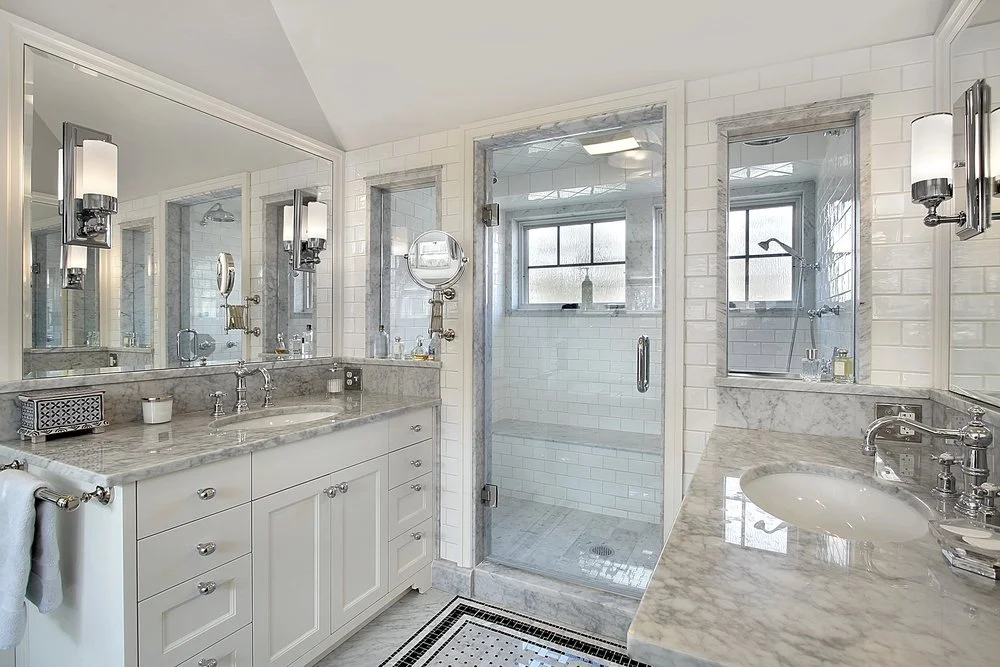Is Your Bathroom Exhaust Fan Working Efficiently?
/This blog post was originally published in February 2019 but recently updated in November 2024 to provide the most accurate and helpful information. We've included new tips, expert advice, and practical solutions to ensure your bathroom exhaust fan is working efficiently.
Is your bathroom exhaust fan ACTUALLY pulling the humidity out of the bathroom or is it just making a lot of noise?
Prefer to listen?
Common Mistake Made
When we provide quotes for bathroom renovations, we always ask homeowners about their exhaust fan. Surprisingly, it’s one of the most commonly overlooked elements in a bathroom renovation—and yet, it’s crucial for preventing moisture damage and maintaining air quality. When we ask clients if their exhaust fan is working, the most common answer we get is,
It’s working just fine! Turn on the switch and listen.
However, just because your fan is making noise doesn’t mean it is ‘working’ at all!
Whenever we are hired to do a home inspection for a potential buyer, one of the tests we do is our 'toilet paper test' to ensure the exhaust fan is truly working. Unless the motor stops functioning completely, your fan will still make noise even if it’s not sucking any moisture out of the room. This can often be the reason why your paint will start peeling from your ceiling or walls in the bathroom.
During colder months, we typically don't open our bathroom windows to let the moisture and humidity out from our showers in the morning. Consequently, we might be leaving our exhaust fans running longer than usual.
Toilet Paper Test
Not sure if your bathroom fan is actually working? Try the simple 'toilet paper test':
Take two pieces of toilet paper.
Turn your exhaust fan on.
Hold the paper near the fan’s vent.
If the fan is functioning properly, it should suction the paper and hold it in place. If the paper falls or barely moves, your fan is just making noise without removing any humidity.
How to Fix the Problem
The first thing to try is washing the fan and the motor. Before beginning, turn off the fan’s power supply at the circuit breaker for safety. Then, follow these steps to clean the motor.
Remove the trim from the fan and wash it thoroughly. Next, unplug the motor and remove it completely. Submerge it in warm soapy water and clean it thoroughly. Take it out, rinse, and let it dry for 48 hours before plugging it back in again. Use a vacuum or damp cloth, and be sure to clean the inside of the housing prior to plugging it back in.
Try the toilet paper test again. If it holds this time, all you needed to do was clean the motor. If it still doesn't hold, it's time for a new exhaust fan.
Why You Need a Functioning Exhaust Fan in Your Bathroom
Bathroom exhaust fans play a critical role in your home’s ventilation system. They don’t just eliminate odours—they help prevent peeling paint, mildew, mould, and even structural damage caused by trapped moisture. Proper ventilation ensures your bathroom stays fresh, healthy, and safe for your family.
Unless a bathroom is properly ventilated, the moisture from a shower has no place to go and can penetrate into drywall, attic insulation, and structural joists. If a mirror is steaming up after a shower or there is a buildup of condensation on the bathroom walls, it may be time to service or upgrade the bathroom fan.
Choosing the right team for any renovation or maintenance project is crucial. Discover what sets us apart from other contractors and how we can help you, whether it’s a small repair or a major upgrade
Maintenance Tips for Your Bathroom Exhaust Fan
Regular maintenance is essential to keep your bathroom exhaust fan working efficiently and prolong its lifespan. Here are some easy tips to ensure your fan stays in top condition:
Clean the Fan Grille
Dust and debris can accumulate on the fan’s grille, reducing airflow. Remove the grille by gently pulling it down or unscrewing it (depending on the model). Wash it with warm soapy water, let it dry completely, and then reattach it.Vacuum the Fan Blades
Turn off the power to the fan at the circuit breaker for safety. Use a vacuum cleaner with a brush attachment to remove dust from the fan blades and housing. This prevents the motor from working harder than necessary.Inspect for Blockages
Check the ductwork and vent leading to the exterior of your home for obstructions like lint or debris. Ensure the vent flap opens and closes freely to allow proper airflow.Replace or Clean the Filter (If Applicable)
Some fans come with built-in filters, especially combination units. Refer to your fan’s manual for cleaning or replacement instructions, and perform this task as recommended by the manufacturer.Test the Fan Regularly
Perform the toilet paper test every few months. Hold a piece of toilet paper up to the fan grille while it’s running; if the fan can’t hold it in place, it may need cleaning or repair.Lubricate the Motor (If Applicable)
For older models with lubrication ports, add a few drops of motor oil every six months. Newer models are usually sealed and don’t require this step.Schedule a Professional Checkup
If you notice unusual noises, reduced performance, or the fan isn’t functioning at all, it’s time to consult a professional. Regular inspections can catch problems early and extend the fan's life.
By following these maintenance steps, you’ll improve your fan’s efficiency, prevent excess moisture buildup, and reduce the risk of mold and mildew in your bathroom. Make it a habit to perform these tasks at least twice a year to keep your bathroom well-ventilated and fresh!
How to Select the ‘Right’ Exhaust Fan
Canada Mortgage and Housing Corporation (CHMC)’s research shows that many bathroom fans across Canada should be replaced or serviced due to inadequate airflow, an inability to overcome static pressure, high leakage rates, and a generally poor condition.
There are several factors to be considered when selecting a new or replacement bathroom fan: airflow rate, sound levels, energy efficiency, aesthetics, and fan control.
Air Flow Rate
The Home Ventilating Institute (HVI) has provided guidelines for the proper ventilation of a bathroom. For bathrooms under 100 square feet, the basic rule is to exhaust a minimum of one cfm (cubic foot per minute) for every square foot of bathroom area. So an 8’ x 10’ bathroom, or 80 square feet, would have a minimum airflow requirement of 80 cfm. For bathrooms over 100 square feet, the calculations are based not on square footage but on the number and type of fixtures in the bathroom. An allowance of 50 cfm should be made for each standard toilet, bathtub, and shower. Allow 100 cfm for whirlpools and hot tubs. For example, a bathroom with a hot tub, shower stall, and toilet would require a minimum of 200 cfm (100 + 50 + 50).
Air make up is an important factor to consider when sizing a bathroom fan. Fans will only remove air from an area at the rate at which it can be replenished, regardless of the correct sizing or rated air flow. In many cases, the space between the bottom of the door and the floor is adequate, but in some cases, an additional air make-up source must be installed to allow the fan to operate at peak performance, such as an additional grille installed in the bathroom door.
Not sure if your bathroom exhaust fan is working effectively? Or maybe you need a new one installed where there wasn’t one before? Let us help! Our team can inspect, replace, or install a fan to ensure your bathroom stays fresh, dry, and free from mold and moisture damage.
Sound Level
The second issue is the sound level of the bathroom fan. Various studies have shown that many people do not turn on their bathroom fans because they are too noisy. When considering fan sound levels, it is important to check the HVI rating. If a bathroom fan does not carry an HVI rating, there is a very good chance that the fan will be noisy. Sound is rated by sones, and the higher the number, the louder the fan will be. A good rating to look for is 1.5 or lower. Be careful not to get one that’s too low; otherwise, you might forget that you left it on.
A quiet alternative to traditional bathroom fans is the remote-mounted in-line ventilation fan. These fans are mounted in the attic, thereby removing the motor and fan assembly from within the bathroom itself, and provide quiet and effective exhaust ventilation to deal with most airflow requirements. By removing the fan assembly from the bathroom space and mounting it remotely, the possibility of the ultimate in quiet operation, virtually zero noise, can be achieved (depending on how far away the fan is mounted). We again caution that some of our customers have left these fans on all day because they couldn’t hear them running and forgot about them.
Energy Savings
With energy savings on everyone’s mind, choosing an Energy Star fan is, without question, the best choice. More than half of the fans operating in Canada today are not energy-efficient models; in fact, some fans in operation today are using more than 180 watts of power. A retrofit of the bathroom fan can lead to savings in the electrical bill and increased performance of the bathroom fan.
Fan Control
This is an important aspect of the ventilation process and something that should be strongly considered. CMHC and HVI both suggest that a bathroom fan run for a minimum of 20 minutes after a shower to allow for the removal of excess humidity and moisture. Many bathroom installations have the fan controlled by the same switch as the light, resulting in the fan being turned off as soon as the occupant leaves the room. It is recommended that a separate switch control the fan or, better yet, a timer that allows the fan to run for a predetermined amount of time after showering.
Our Favourite Bathroom Exhaust Fans
Selecting the right bathroom exhaust fan is crucial for maintaining proper ventilation and preventing moisture-related issues. Here are some efficient exhaust fan recommendations tailored to various bathroom sizes:
1. Small Bathrooms (up to 75 square feet):
Broan-NuTone LoProfile, 80 CFM, 1.0 Sone Bathroom Fan (for bathrooms up to 75 sq. ft.)
CFM: 80
Noise Level: 1.0 sones
Features: Compact design suitable for small spaces
Note: Ideal for half baths or powder rooms.
2. Medium Bathrooms (70 to 100 square feet):
CFM: Selectable 80 or 110
Noise Level: 0.5 to 0.8 sones
Features: Quiet operation; includes dimmable LED light and nightlight; Energy Star certified.
Note: Suitable for medium-sized bathrooms; adjustable airflow settings.
3. Large Bathrooms (over 100 square feet):
Panasonic 130-150 CFM 0.4-0.6 Sones Whisper Choice Bath Fan (for rooms < 140 sq. ft.) ENERGY STAR®
CFM: 130 and 150
Noise Level: 0.2 to 0.3 sones
Features: Energy-efficient; customizable airflow; quiet operation.
Note: Designed for large bathrooms; multiple airflow options to suit various needs.
4. Fans with Additional Features:
Home NetWerks Bath Fan and Speaker in One - 70 CFM with Bluetooth Speaker and LED Light
CFM: 70
Noise Level: 1.5 sones
Features: Built-in Bluetooth speaker; dimmable LED lights; suitable for installation over showers with GFCI protection.
Note: Combines entertainment with functionality; ideal for tech-savvy users.
Broan-NuTone 110 CFM Humidity Sensing Exhaust Fan
CFM: 110
Noise Level: 1.0 sones
Features: Automatic humidity sensing; Energy Star certified.
Note: Automatically activates when humidity levels rise
When selecting an exhaust fan, consider the size of your bathroom, desired features, and noise levels to ensure optimal performance and comfort.
Common Signs Your Exhaust Fan Needs Replacing
The fan is noisy but doesn’t suction air.
Moisture or mildew is building up, even with regular fan use.
Paint is peeling from your ceiling or walls.
The motor doesn’t respond even after cleaning.
Did this blog post inspire you to check the efficiency of your exhaust fan? If so, let us know in the comments below what the outcome was and how you found the post helpful. We’d love to hear from you.
Want to learn more about bathroom renovations? Check out some of our blogs below:
Maximize Your Home’s Value: Converting a Powder Room to a Full Bathroom
15 Ideas to Revamp Your Bathroom on a Shoestring Budget
Curb or Curbless: Which Type of Walk in Shower is Right for You
7 Must Know Tips for Renovating Your Bathroom
Whether you’re planning your dream renovation or need help with something as simple as assessing your exhaust fan, we’re here to help. Contact us today to see how we can make your home work better for you!






























